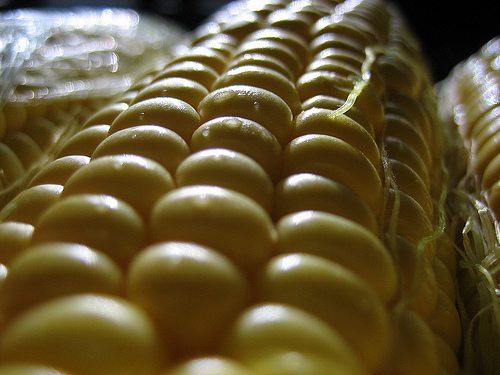All about: Corn
This week in the "All About" series, let's talk about corn! Corn is a classic late-summer treat here in the states. Even in the Pacific Northwest where I live, fresh locally grown corn is a highly prized summer item. This year the corn harvest clocked in a little later than usual, so our local corn is only just now starting to hit the market. In most areas, August is the peak of corn season - just in time for prime picnic weather.

Image courtesy Flickr/vistavision
Corn is kind of a contentious topic these days. Our nation's food supply is heavily based on corn, not just in the corn meal that gets used in everything, but in the high fructose corn syrup that we slather across the entire grocery store. Corn is so cheap and plentiful (thanks to government subsidies) that we feed it to our cattle, even though they aren't designed to eat it and it makes them sick. But who cares! It's cheap and fattening! Eat up!
Having started a low-carb diet this year, I have become extremely aware of corn's ubiquitous nature. It's incredibly difficult to avoid eating corn in America, and most of the forms in which we eat corn are, quite frankly, terrible.
However, even on a low-carb diet, you can make a little room for an ear of fresh corn on the cob once or twice a year. Fresh local corn, lightly cooked and minimally prepared, is an amazing thing. The longer an ear of corn sits after it has been picked, the more its sugars break down to bland starch, so the fresher the corn, the better. An ear which has just been picked from the garden is like sunshine on the plate.

Image courtesy Flickr/Let Ideas Compete
From a nutritional standpoint, corn has little to offer beyond raw calories. Don't get me wrong, calories were an important dietary consideration for the early people who first domesticated corn from a wild grain. And calories continue to be a critical factor for many people around the world today. Corn, as a cheap source of calories which is easy to grow, is still an important global crop. Just not so much for most of us privileged westerners.
However, whole corn (which includes both corn on the cob and popcorn) has a lot of insoluble fiber, so there's that. Corn on the cob has the additional benefit of tricking you into thinking you have eaten more than you really have, since you have to work at it to get those kernels. (Compared to just spooning corn out of a bowl.)
Buying and storing corn
The brighter green and juicier the husk, the fresher the corn. As corn ages, the husk becomes dry and pale. You definitely want to buy corn which is as fresh as possible.
Don't husk the corn until you are ready to cook it. Cook it within two days of purchase. Ideally, that same night. If you have to keep corn until it's time to cook it, refrigerating it will help slow down the aging process.

Image courtesy Flickr/WayTru
Cooking corn
Fresh corn on the cob basically only needs to be heated through. An easy way to do this is in the microwave, either in the husk or already shucked. One or two minutes on high, just long enough to get the corn steaming, will do the trick.
Another popular method of cooking corn on the cob is to simmer it in a pot of water. DO NOT add salt to the water, as this will make the corn tough. Bring the pot of water to a boil, drop in the corn, and let it simmer for just a few minutes. Again, a lighter touch is better. The corn is done when it steams if you pull an ear out of the water.
And finally, there is the matter of grilling corn. You can either steam it by wrapping it in aluminum foil, or give it a proper grilling. Or you can use a hybrid approach: steam it until the kernels are heated through, then grill it for a few minutes to give it some delicious sear marks.
Leftover corn can be wrapped in plastic film and reheated the next day. Or if you want to save fridge space, you can carefully slice the kernels off the cob and store them in a tub until you are ready to eat them. (Which will probably not be very long!)
Main image courtesy Flickr/jungmoon
